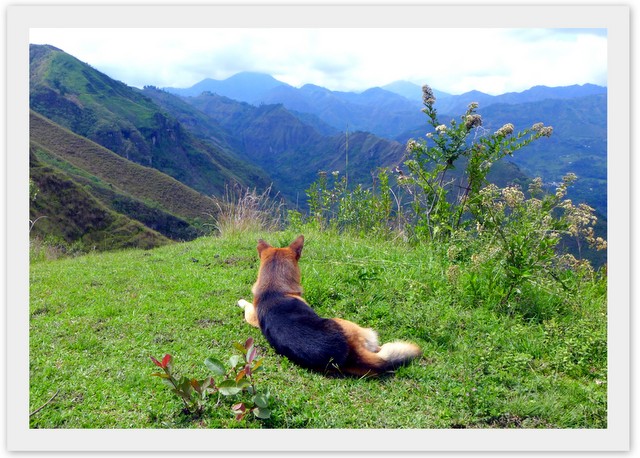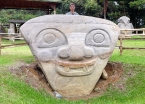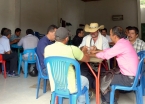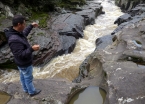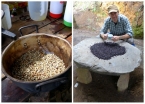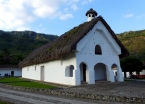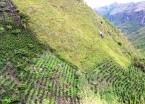
I had no intention of visiting San Agustín and Tierradentro. But after perusing the information wall at the excellent Hosteltrail.com hostel, the Colombian Heritage Circuit struck me as the perfect four-day getaway to an interesting and not-very-visited part of the country.
This is an area that only recently opened to tourists. Long the domain of leftist People’s Army, a.k.a. FARC guerrillas (Fuerzas Armadas Revolucionarias de Colombia), the Colombian army has succeeded in pushing anti-government forces out. While I felt safe in my travels so far in Colombia, my current guidebook (published only months prior) still had intriguing warnings on specific routes:
You should not travel after dark, not because of guerrilla activity but rather due to late-night bandits…
I asked several locals in Popayán and no one seemed to think the area or the journey were all that risky. So off I went, during daylight hours of course.
San Agustín and Tierradentro are the sole UNESCO World Heritage architectural sites in Colombia, important reminders of the ancient culture of southern Colombia that dates from 4000 BC when settlers established agricultural communities and thriving trade connections.
Unfortunately little is known about this civilization. But hundreds of unearthed statues remain, beautifully sculpted from volcanic rock, represent humans, sacred animals and even fantastical monsters. Today these are viewed atop panoramic altos (hilltop burial grounds) overlooking emerald forests.
I arrived safely to San Agustín town after an uneventful (yet bumpy) bus ride through the sparsely populated Andean hills. I did see armed Colombian soldiers patrolling the roads but the only apparent threat were the hairpin turns on unpaved roads that teetered above steep chasms.
San Agustín is a boom town, more bustling than I expected. Tourism is set to take off with newly-arrived expats opening traveler-oriented businesses. I was greeted warmly at the flashpacker-chic Bambú Hostal where I spent a couple comfortable and undisturbed nights. Cheery Dionisio, the jazz-playing Argentine hipster who owns the hotel, pointed me to the remarkably tasty Tomate Verde, a healthy vegetarian restaurant run by a gifted German cook.
Despite its burgeoning tourism, I loved the rustic feel of San Agustín. After days in large and lustrous Popayán, I rolled into town on market day and found roads bursting with horses and cows, carts laden with provisions, and bars filled with cowboys sitting around tables crowded with empty Poker beer bottles. Yet San Agustín was decidedly friendly and I relaxed when not visiting the burial statues or traipsing on horseback through the outskirts to waterfalls, coffee plantations and lulu fruit orchards. I could have happily spent many more days there.
San Agustín’s surrounding countryside has lots on offer so one morning I went horseback riding to visit other archaeological sites including La Chaquira (not the singer, rather a striking carved rock depicting gods and overlooking the Río Magdalena valley) and Alto del Purutal which features colorfully painted statues, including a pregnant woman.
Once day I joined a tour with three Aussies, characteristically touring the whole of South America, to marvel at El Estrecho (The Narrows) where the mighty Magdalena River is squeezed to two meters by a tight Andean gorge.
A highlight was our visit to a crude sugarcane processing plant. Harvested year-round, thick caña rods are machine crushed to extract guarapo (sugarcane juice) which is boiled in vats until a thick paste forms. This is then dried in wooden molds to create crumbly amber panela blocks of unrefined sugar which is sold at local markets.
Panela is a healthy and sustainably produced sweetener – the dried canes (after the juice is extracted) fuel the fires used for boiling and the foamy runoff from the paste is used as feed to fatten chickens. There is no refining so more natural nutrients are preserved.
Panela has a distinct taste (hinting of molasses) and is consumed everywhere in the region. I adjusted quickly to panela-sweetened coffee, juices and baked goods. I grew especially fond of homemade cucas, treacle-tasting cookies sold by street vendors.
Colombia is obviously famous for its coffee and the rich earth of San Agustín offers a fertile zone for this caffeinated crop. While riding horses I stopped at a small family-run coffee farm to sample a hot cup. Showing off a toothy smile, the proprietor kindly showed me how she roasts dried beans over a wood fire. I sipped my steaming cup as baby chickens ran about my feet and hummingbirds zipped from bloom to bloom.
Interestingly, all premium-grade beans of harvested from Colombian coffee fields are sold to local cooperatives for export. Virtually all beans consumed within Colombia, while rougher around the edges, can be very tasty thanks to their freshness.
Throughout Colombia I witnessed locals dropping off bags of hand-picked beans at village stores. Shopkeepers buy raw beans from farmers and re-sell them to collectives who prepare them for export. The current price is 1,500 Colombian pesos per kilo – that’s about USD $0.42 a pound, a meager payback for a labor-intensive crop. With high living costs Colombia, many coffee workers struggle.
Tierradentro was my next destination, a half-day journey from San Agustín that required five vehicles: two taxis, a van, a bus and the back of a pickup truck. On my last leg, I shared a collective taxi with a young man on leave from the Colombian army where he serves in the Amazon where guerrillas still lurk. An indigenous Páez (natives of this area), Luís explained how his people were long excluded from the national military as they were assumed to support anti-government militants.
He seemed happy with his chosen career path despite the long periods away from his young family. The army has given him an opportunity to complete secondary school and receive vocational training that he hopes will serve him as a civilian. He spoke highly of the Special Forces troops from the United States who serves alongside him and who have taught him much about soldierly discipline and, curiously, the importance of drinking lots of water in the tropics which he says is not a priority to his people.
Despite the huge leap forward in recent years regarding Colombia’s security, Luís’ narrative was a sober reminder of the United States’ continuing presence here (however subdued) fighting both the drug war and leftist insurgents. This contrasts other Andean countries whose socialist governments have removed the United States military from their borders.
By evening we arrived in charmingly petite San Andrés de Pisimbalá, an ethnic Páez village that largely ignores the trickle of tourists who wind their way here. I only saw one other tourist, a Swiss student who practiced her flute by playing classical melodies much to the delight of curious villagers strolling past our hotel, Posada La Portada. There I enjoyed idle afternoon conversation on the porch with the owner and delicious home-cooked vegetarian meals lovingly prepared by his wife.
Yet the village itself seems unperturbed by the few outsiders who journey here. Its lively market starts well before sunrise and children climb the imposing boulder perched in front of a distinctive thatched church. Elders chat on benches, men play cards and drink beer while children and parents promenade arm-in-arm around the main square. Despite its reputation in years past as a safe harbor for FARC guerrillas, now only friendly faces and tranquility infuse San Andrés.
The next morning I set off in bright sunshine on a hike to the major archaeological sites scattered throughout the mountains. I was accompanied by three spirited dogs from the village, two of which gamely stuck with me the whole 14-kilometer journey.
While San Agustín’s excavated statues sit above ground, Tierradentro’s wonders are found beneath the surface. Elaborate tombs buried as deep as nine meters were carved out of the volcanic rock between the 7th and 9th centuries AD. These subterranean chambers feature thick pillars which support the domed roofs and walls adorned with brightly painted geometrical patterns. Sadly the burial tombs suffered widespread looting so few clues remain to unlock the secrets of this civilization.
Mystical and majestic, I pondered the tombs and landscape as I meandered along the trail. With the day ending I descended the mountain and was greeted by San Andrés villagers as the sun sank behind the Andean peaks.
My feet were weary but my spirit was soaring. I didn’t want this hike to end. I didn’t want to leave this precious corner of southern Colombia. Places like these are the traveler’s greatest prize: unspoiled terrain and attention-grabbing sites, rough-but-rewarding transport, relaxing accommodation, and inquisitive-yet-smiling locals. Beaming from every angle, San Agustín and Tierradentro are champion destinations in my travel book.
